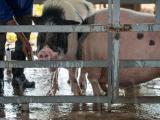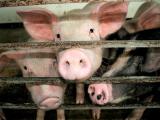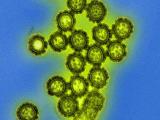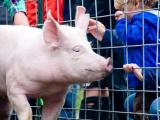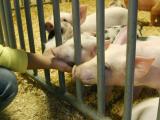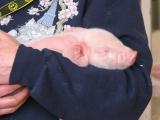Jul 25, 2012 (CIDRAP News) – Four people who exhibited pigs at a recent county fair in Indiana were infected with a novel swine-origin H3N2 influenza strain, raising the number of such cases reported in the past year to 17, according to Indiana health officials.
The four patients had illnesses resembling typical seasonal flu and have all recovered, according to Pam Pontones, MA, Indiana's state epidemiologist. They showed pigs at the LaPorte County Fair in northwestern Indiana, which was held Jul 8 to 14.
None of the patients were seriously ill or hospitalized, Pontones told CIDRAP News. She said the patients were a variety of ages, but for confidentiality reasons she declined to disclose their specific ages or other details about them.
The same H3N2 variant—which was previously dubbed H3N2v—was found in all 12 pigs shown at the fair that were randomly selected for testing, according to Denise Derrer, a spokeswoman for the Indiana State Board of Animal Health (BOAH).
All the human patients worked closely with swine, Pontones said, adding, "We have not identified any cases that appeared to be transmitted person to person. All four appeared to have direct swine contact, which facilitated transmission."
She said the Indiana State Department of Health (ISDH) is still investigating the outbreak by gathering information from those who showed pigs at the fair and looking for any other cases and signs of person-to-person transmission.
Thirteen previous human cases of infection with H3N2v have been reported since last September. Counting the four latest ones, six cases have been reported in Indiana, the ISDH said in an e-mailed press release.
The strain is a reassortant that includes the matrix (M) gene from the 2009 H1N1 pandemic virus. Pontones said testing by the US Centers for Disease Control and Prevention (CDC) has confirmed that the four new cases involve the same variant.
The first two infections with the novel strain, reported in September 2011, were in Indiana and Pennsylvania, according to previous reports. Most of the cases have been in children. The latest previous case was reported in a Utah child in April.
Derrer, of the BOAH, said that of the 12 pigs that were randomly chosen for testing, some were showing signs of illness and some were not.
She said no further testing of pigs is being done, but the ISDH is conducting a telephone survey of all the swine exhibitors at the fair, and the survey includes a set of questions about animal health.
"We have seen this H3N2 [strain] in swine before," Derrer said. "From our perspective, having an influenza virus is not an unusual event. We have had flu viruses diagnosed in swine since the 1930s."
Among earlier H3N2v cases, about half the patients had exposure to swine, according to previous reports. But Derrer said her understanding is that this is the first time that the novel H3N2 strain has been seen in humans who clearly had direct contact with pigs known to be infected with the same strain.
Flu viruses are not transmitted by eating properly handled and prepared pork or pork products, according to the CDC.
In April the CDC said it had produced a candidate H3N2v vaccine virus, and that a vaccine was being developed and would probably be ready for clinical trials in the coming months.
Results of a serologic study released by the CDC in April suggested that children under age 10 were likely to be at greatest risk for contracting H3N2v.
The ISDH statement said people who have direct, routine contact with swine and have experienced cough or flu-like illness should contact their healthcare provider or local health department. Symptoms include cough, sore throat, fever, body aches, and possibly nausea, vomiting, or diarrhea.
In addition, the BOAH said swine owners should contact a veterinarian if their animals show signs suggesting flu.
See also:
CDC information about swine-origin flu viruses in humans
Apr 12 CIDRAP News story "Study: Variant H3N2 risk greatest in kids under 10"
Dec 23, 2011, CIDRAP News story "CDC reports two more novel flu infections"
Sep 2, 2011, CIDRAP News story "Novel H3N2 swine flu viruses infected 2 children, CDC says"
